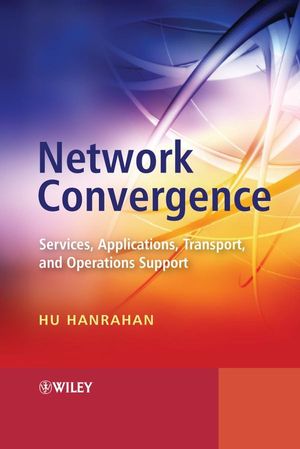|
Textbook
Network Convergence: Services, Applications, Transport, and Operations SupportISBN: 978-0-470-02441-6
Hardcover
464 pages
April 2007, ©2006
 This is a Print-on-Demand title. It will be printed specifically to fill your order. Please allow an additional 10-15 days delivery time. The book is not returnable.
|
||||||
Acknowledgments.
Conventions.
Companion Website.
Abbreviations.
Principal Graphic Symbols.
1 Setting the Context for Evolution and Convergence of Networks.
1.1 Historical Background to Present Networks.
1.2 Defining Present State Using Reference Models.
1.3 Evolution and Convergence.
1.4 The Next GenerationNetwork Concept.
1.5 Conclusion.
2 A Framework for Examining Next Generation Networks.
2.1 Characteristics of Evolving Networks.
2.2 Dealing with Complexity.
2.3 Framework for EvolvingNetworks.
2.4 Examples of Application of Framework.
2.5 Conclusion.
3 Software Methodologies for Converged Networks and Services.
3.1 Development of Software Methodologies for ICT.
3.2 Software Processes in the NGN Framework.
3.3 High-level Analysis and DesignMethods.
3.4 Enterprise and Business Modelling Notation.
3.5 Object and Data Definition Languages.
3.6 Dynamic Modelling Notations.
3.7 Component and Interface Notations.
3.8 Distributed Systems.
3.9 Creating a Unified Framework.
4 An NGN: the Managed Voice over IP Network.
4.1 Development of Packet Multimedia Standards.
4.2 Requirements on a Managed Voice Network.
4.3 Properties of Packetised Voice.
4.4 General Concepts of Multimedia Communications.
4.5 Signalling Plane for Packet Multimedia.
4.6 The H.323 Suite.
4.7 Media Gateway Functions and Control.
4.8 Multimedia Communications Based on SIP.
4.9 Supplementary Services in Packet Telephony.
4.10 ITU-T Evolutionary Protocols: BICC.
4.11 Voice on the Internet.
4.12 Conclusion.
5 Integrated Enterprise ICT Systems.
5.1 Drivers and Requirements.
5.2 Contributions to Convergence.
5.3 Network Level Convergence.
5.4 Application and Service Level Convergence.
5.5 Conclusions.
6 Legacies and Lessons: Broadband ISDN, TINA and TIPHON.
6.1 Learning from History.
6.2 The Broadband ISDN.
6.3 TINA Architecture.
6.4 Business Model and Reference Points.
6.5 TINA Service Architecture.
6.6 Network Resource Architecture.
6.7 Lessons from TINA for NGNs.
6.8 TIPHON.
6.9 Conclusion.
7 Important NGNs: Third Generation Mobile Communication Systems.
7.1 Architectural Concepts.
7.2 Mobile Communication System Evolution.
7.3 Services in the CS Domain.
7.4 Packet-switched Domain: GPRS-based Systems.
7.5 IP Multimedia Subsystem.
7.6 Conclusion.
8 Opening the Network using Application Programming Interfaces.
8.1 Closed Network Evolution.
8.2 Opening the Network.
8.3 The OSA/Parlay Architecture.
8.4 Framework Interfaces and Use Cases.
8.5 The OSA/Parlay Gateway.
8.6 Communication-orientatedUse Cases.
8.7 ParlayXWeb Services.
8.8 OSA/Parlay API Implementation Issues.
8.9 Other Approaches to Open Networks.
8.10 Conclusion.
9 Operations Support Systems.
9.1 Relationship of OSS/BSS to ICT Systems.
9.2 Evolution of OSS/BSS.
9.3 The Telecommunications Operations Map.
9.4 Enhancement of the TOM: eTOM.
9.5 New Generation OSS.
9.6 Conclusion.
10 Migration from Legacy to Next Generation Networks.
10.1 Retrospect.
10.2 Reflecting on Evolution and Convergence.
10.3 TechnologyMigration.
10.4 Is There a Target NGN?
10.5 Managing Complexity: Avoiding Pitfalls.
10.6 A Last Word.
Glossary.
References
Index.



